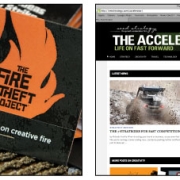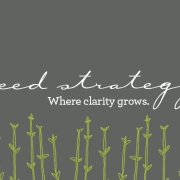The 7 Strategies for Fast Competition
When directing your brand or business, do you ever feel like you’re running a never-ending race, constantly pushing farther and faster just to keep up?
Except, as soon as you’re only a few feet away from the finish line, it moves further, and the race goes on another day. Ugh. Well, you’re not alone. Seed Strategy’s SVP, Director of Innovation, Rolando Archila, offers seven ways to stay on track and hit the finish line every time.
Today’s brand environment is in fact the meanest, dirtiest, fastest and —for some of us speed junkies— the most exhilarating race to have ever existed. Nothing is certain, enemies are masked as allies, traps lie in every corner.
Go, Speed Racer, go!
But one thing is certain: for fast competition, you need a clear direction. The goal is the same for all, and that’s to win. But the how, the way in which you get there, that is strategy. And you can only choose one. So a strategy is, in essence, a choice of path. A choice of where to play, when to act and of how to spend resources. However, too often brands zig and zag on the racetrack, wavering in their actions, shifting gears willy-nilly at the whim of the latest consumer trend or shareholder meeting. The most successful brands have a clear strategy, a precise, long-term direction in which they’re racing. The exact strategy you develop has to be custom-tailored according to your equity, category, competition and consumer. It must be driven by your unique points of difference. That said, it helps to know that at the macro level, most strategies roll up to 1 of 7 overarching buckets. See them below, determine which one can get you to your goal the fastest and hit the gas. So rev your engines. Check your lights. The flag is about to wave.
Ready… Set… GO!!!
 1. Be the Biggest. The first strategy is the one most often associated with success, although that doesn’t mean it’s necessarily true. This choice is about mass appeal and ubiquity, selling millions (or even billions) of units and having your logo on every billboard and bus stop. And while being well-known and celebrated is a nice reward in itself, this approach has its drawbacks: a significant investment is often required, both in time and money, and “quality” is often determined by the lowest common denominator. Brand Example: Coca-Cola, Microsoft
1. Be the Biggest. The first strategy is the one most often associated with success, although that doesn’t mean it’s necessarily true. This choice is about mass appeal and ubiquity, selling millions (or even billions) of units and having your logo on every billboard and bus stop. And while being well-known and celebrated is a nice reward in itself, this approach has its drawbacks: a significant investment is often required, both in time and money, and “quality” is often determined by the lowest common denominator. Brand Example: Coca-Cola, Microsoft
 2. Be the Smallest Some brands want to reach every corner of the planet. Others are very happy in one very tiny crevice, thank you very much. These brands live to serve a very specific niche, and serve it very well. The trade-off: Scalability is harder to achieve, so growth and exposure can be limited. But the reward? Handsome margins, of course. Brand Example: Tesla
2. Be the Smallest Some brands want to reach every corner of the planet. Others are very happy in one very tiny crevice, thank you very much. These brands live to serve a very specific niche, and serve it very well. The trade-off: Scalability is harder to achieve, so growth and exposure can be limited. But the reward? Handsome margins, of course. Brand Example: Tesla
 3. Be the Quickest This strategy is about being in the perpetual forefront, maintaining vogue status through constant cycles. Fashion brands often fall into this camp. Being successful requires a high amount of creativity paired with operational efficiency. But, because products cycle at lightning speed, significant risk is often incurred when innovating. Brand Example: Louis Vuitton, Zara
3. Be the Quickest This strategy is about being in the perpetual forefront, maintaining vogue status through constant cycles. Fashion brands often fall into this camp. Being successful requires a high amount of creativity paired with operational efficiency. But, because products cycle at lightning speed, significant risk is often incurred when innovating. Brand Example: Louis Vuitton, Zara
 4. Be the Gold Standard Think luxury. When you are the gold standard, there is no higher consumer aspiration than to own (and, let’s face it, be seen with) your product. The good news: when you’re the gold standard —the mark of prestige— you can also charge the highest price. The less-good news: your market size is likely very limited, and you can rest assured that you’ll have plenty of competitors who will seek to copycat your product and sell it at a lower price. Brand Example: Tiffany & Co., Mercedes-Benz
4. Be the Gold Standard Think luxury. When you are the gold standard, there is no higher consumer aspiration than to own (and, let’s face it, be seen with) your product. The good news: when you’re the gold standard —the mark of prestige— you can also charge the highest price. The less-good news: your market size is likely very limited, and you can rest assured that you’ll have plenty of competitors who will seek to copycat your product and sell it at a lower price. Brand Example: Tiffany & Co., Mercedes-Benz
 5. Be the Cheapest Now that we’ve explored the gold standard, let’s look at the polar opposite: be the cheapest. For these companies, there is but one goal: have the lowest price, period. Because the small margins must be offset with high volume, this strategy is often confused with “Be the Biggest,” #1 above. But for companies under this low-priced strategy, size is often born out of necessity, rather than choice. Brand Example: Walmart, Southwest Airlines
5. Be the Cheapest Now that we’ve explored the gold standard, let’s look at the polar opposite: be the cheapest. For these companies, there is but one goal: have the lowest price, period. Because the small margins must be offset with high volume, this strategy is often confused with “Be the Biggest,” #1 above. But for companies under this low-priced strategy, size is often born out of necessity, rather than choice. Brand Example: Walmart, Southwest Airlines
 6. Be the First Mover If you see people lining up for a mind-blowingly awesome product you’ve never heard of before, one of these companies probably created it. This strategy is most frequently (but not exclusively) seen in technology companies, where being on the bleeding edge is valuable currency. This strategy requires vision and flawless execution. But most importantly, it requires guts… to be a true first mover, you have to be willing to obsolete (gulp!) even yourself. Brand Example: Apple, SpaceX
6. Be the First Mover If you see people lining up for a mind-blowingly awesome product you’ve never heard of before, one of these companies probably created it. This strategy is most frequently (but not exclusively) seen in technology companies, where being on the bleeding edge is valuable currency. This strategy requires vision and flawless execution. But most importantly, it requires guts… to be a true first mover, you have to be willing to obsolete (gulp!) even yourself. Brand Example: Apple, SpaceX
 7. Be the Service Leader For these brands, it’s all about customer service. Significant resources are spent on fostering an internal culture that reflects this. Their point of difference is the unique way in which they go out of their way to tell the customer “we care about you, and let us prove it.” Brand Example: American Express, Zappos
7. Be the Service Leader For these brands, it’s all about customer service. Significant resources are spent on fostering an internal culture that reflects this. Their point of difference is the unique way in which they go out of their way to tell the customer “we care about you, and let us prove it.” Brand Example: American Express, Zappos
Which strategy fits your brand? Where would you like your brand to fit? The magic will lie in selecting the right path for you —both now and in the long-term. Experience and vision are required to act fast and in the right direction.










You make some great points. You might want to check the book Blue Ocean Strategies.
Thanks Tony! That’s one of our favorite books. Have a great day ~ Jeff